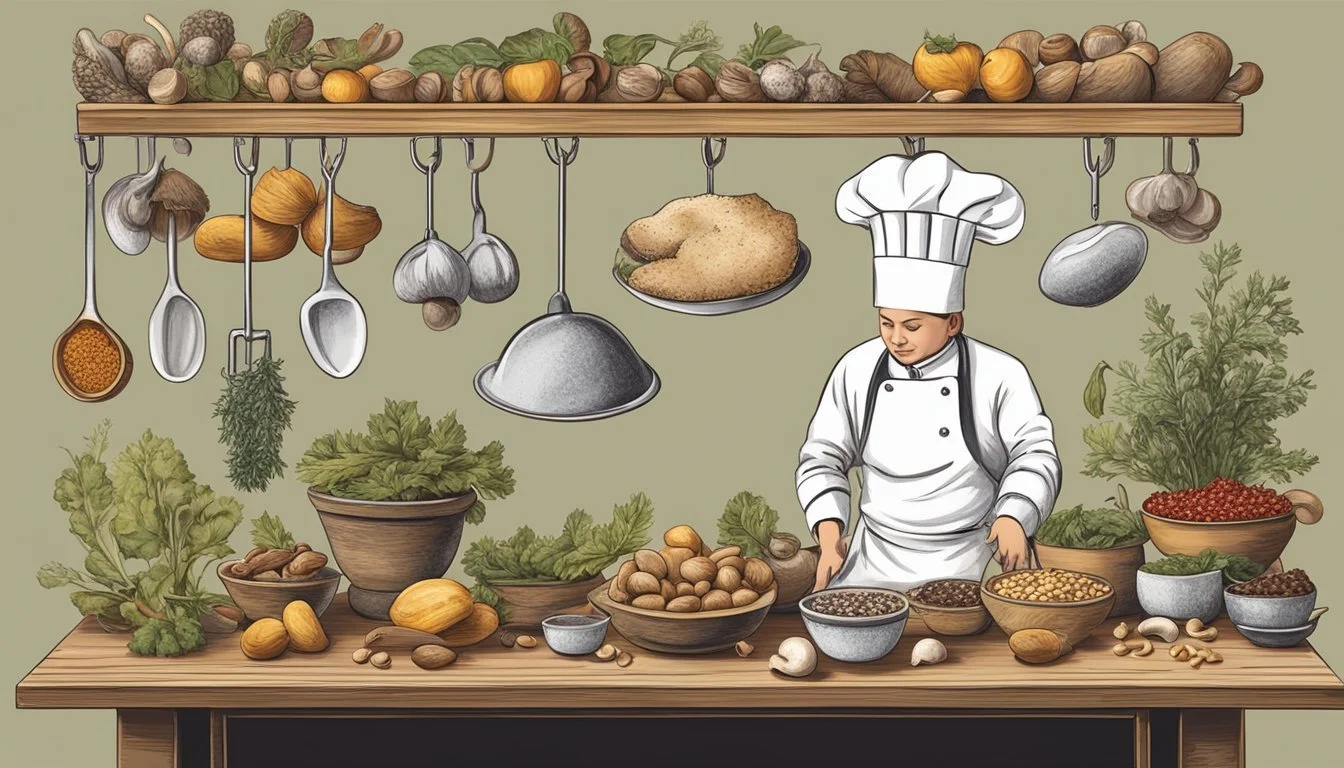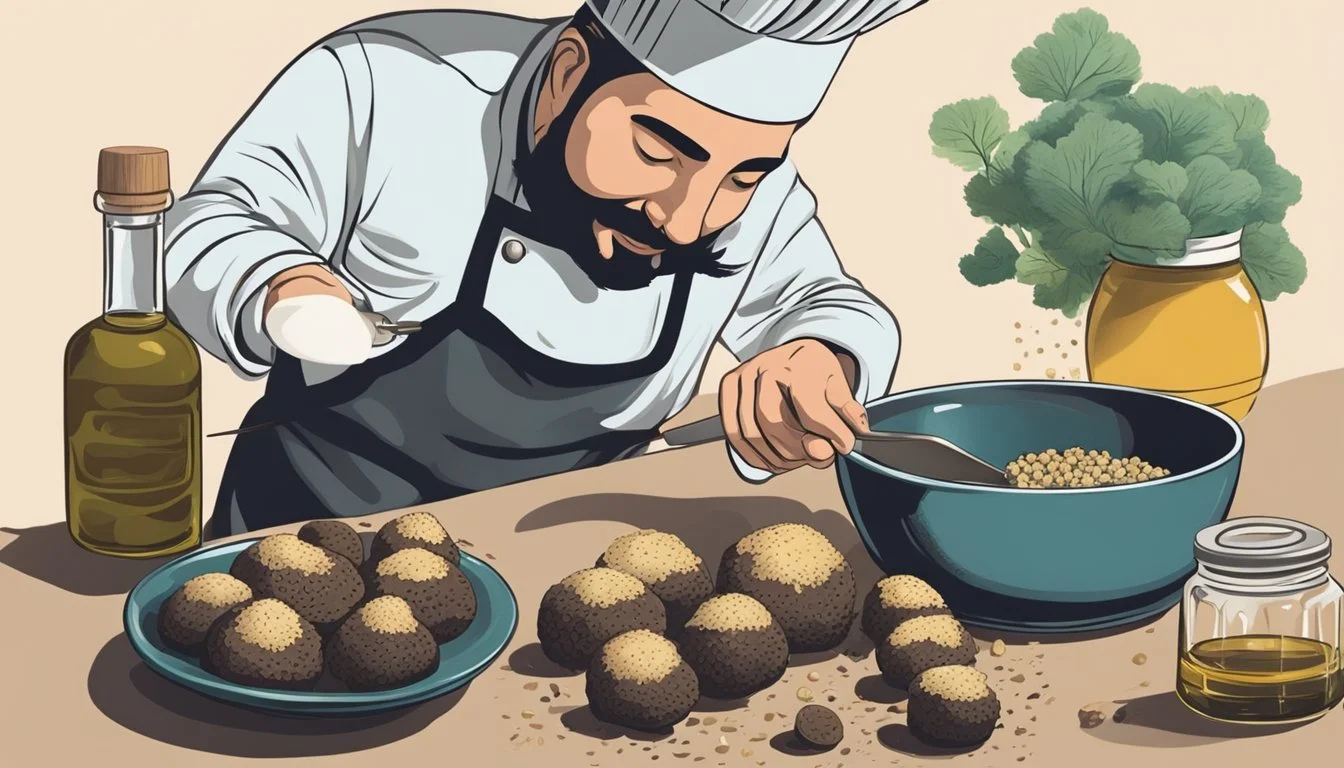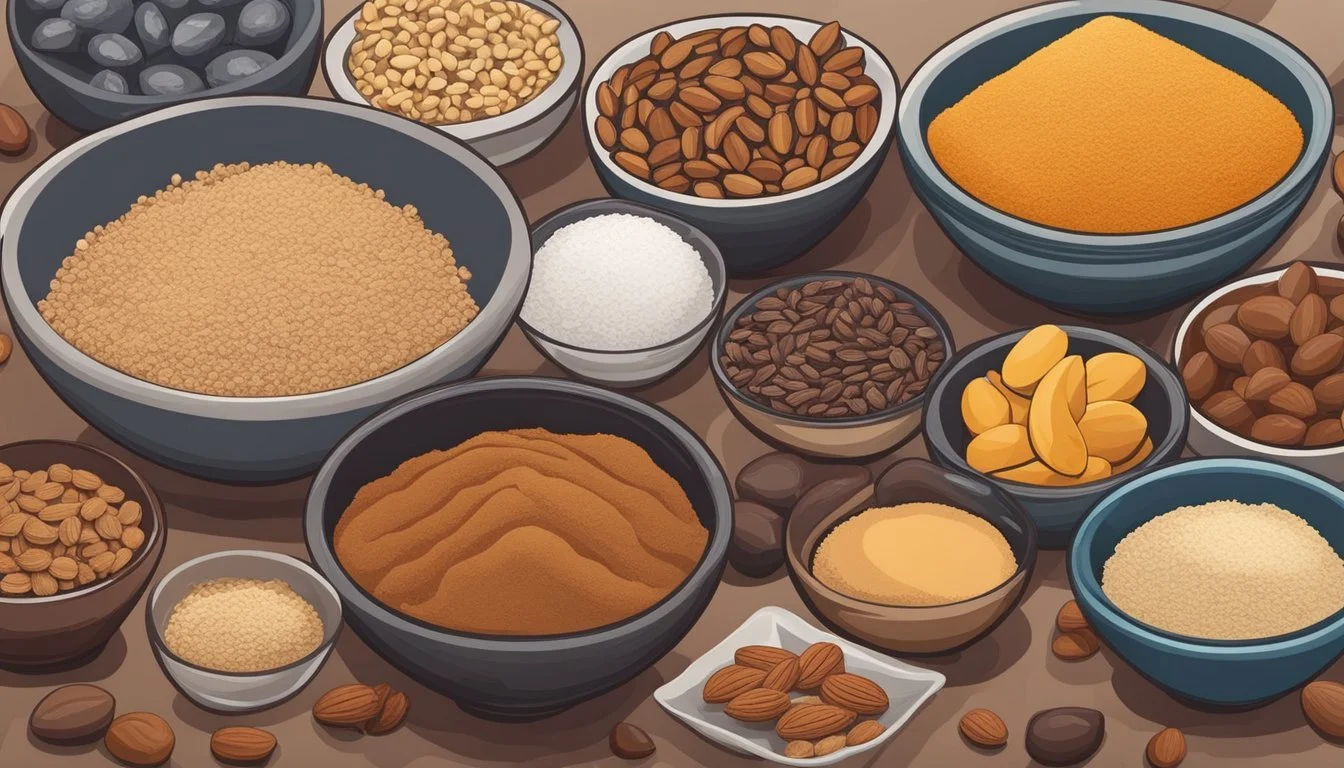Truffles Substitutes
Best Alternatives for Gourmet Cooking
Truffles are renowned for their luxurious, distinct flavor, but their high cost and limited availability often make them inaccessible for many. For those seeking that unique umami taste without breaking the bank, there are several alternatives that can mimic the essence of truffles. Black trumpet mushrooms, truffle oil, black garlic, soy sauce, and Parmesan cheese offer more affordable ways to infuse meals with truffle-like flavors.
Many people may not realize that different types of truffles exist, each with its own price range and harvest season. Despite the price variations, the allure of a truffle's unique flavor profile can often be replicated with these substitutes, making gourmet cooking more accessible to everyone. Whether enhancing a homemade dish or exploring new culinary delights, these alternatives provide a practical solution for adding truffle-like taste without the hefty price tag.
The Basics of Truffles
Truffles are a luxurious ingredient known for their unique, earthy aroma and flavor. They are foraged, harvested, and prized in culinary circles as a delicacy.
Understanding Truffles
Truffles are a type of fungi that grow underground, primarily in the root systems of trees like oaks and hazelnuts. Known for their robust, earthy aroma, they are a sought-after delicacy.
There are two main types: black and white truffles. Black truffles have a more subtle, earthy flavor, while white truffles are sharper with garlicky notes. The harvesting process involves specially trained dogs or pigs to locate these buried treasures.
Culinary Applications and Importance
In the culinary world, truffles are celebrated for their ability to enhance dishes with their unique, earthy flavors. They are often shaved over pasta, risotto, and eggs to add a luxurious touch.
Truffle oil, an infusion of olive oil with truffle essence, offers a budget-friendly way to incorporate truffle flavor into dishes. Truffles are also used in sauces and pâtés. Their aroma and distinct taste elevate the dining experience, making them a prized ingredient in fine dining.
Common Truffle Varieties
Truffles are renowned for their unique and pungent flavors, which vary significantly between the types of truffles. Black truffles and white truffles are among the most illustrious, cherished for their distinct qualities and culinary uses.
Characteristics of Black Truffles
Black truffles, scientifically known as Tuber melanosporum, are prized for their deep, earthy flavors. They have a rugged exterior and are often referred to as the "black diamonds" of the culinary world.
These truffles are typically harvested in France, Italy, and Spain during the winter months. Their aroma is intensely pungent, described as earthy, musky, and sometimes reminiscent of undergrowth. The flesh is dark with white marbling, making them visually distinctive when sliced.
Black truffles are robust enough to complement hearty dishes. They pair well with ingredients like meat, cheese, and pasta. Their rich flavor is best enjoyed when shaved or thinly sliced to enhance the dish without overpowering it.
White Truffles and Their Distinctiveness
White truffles, or Tuber magnatum, are even rarer and more expensive than their black counterparts. These are predominantly found in the regions of Piedmont, Italy, especially around Alba.
White truffles have a smooth, pale exterior and release a potent aroma, often compared to garlic combined with earthy musk. Their flesh is more delicate, with a slight marbling that sets them apart visually.
The flavor of white truffles is subtler yet unmistakably rich and complex. They are often used raw, thinly shaved over dishes, to preserve their distinctive aroma and flavor. Common pairings include eggs, pasta, and risotto, where their delicate essence can truly shine.
In terms of usage, white truffles are typically reserved for finishing touches rather than cooking, ensuring their unique qualities are highlighted.
Exploring Truffle Substitutes
For those who crave the unique flavor of truffles but find them too extravagant, there are several viable substitutes. From affordable alternatives and mushroom-based replacements to variations of truffle oil and salt, you can achieve a similar taste in your dishes without breaking the bank.
Affordable Alternatives to Truffles
Truffle salt and truffle oil are some of the most accessible and cost-effective substitutes. Truffle salt combines sea salt with grated truffles, providing a hint of truffle flavor that can enhance salads, soups, and baked dishes. Truffle oil is another convenient option, mainly used as a finishing touch to impart truffle aroma and flavor.
Porcini mushrooms serve as a budget-friendly substitute, offering a rich, umami taste. They can be used fresh or dried and are especially useful in soups, sauces, and risottos.
Mushroom-Based Substitutes
Black trumpet mushrooms, often dubbed "the poor man's truffle," are noteworthy substitutes. They are potent and have truffle-like subtleties, making them a great addition to dishes that traditionally use truffles. Their earthy, robust flavor pairs well with meats and pasta.
Yellowfoot chanterelles are another option, providing a slightly fruity aroma that can mimic the delicate notes of truffles. These mushrooms work well in sautés, soups, and creamy sauces, delivering both taste and texture.
Using Truffle Oil and Truffle Salt
Using truffle oil and truffle salt can be an excellent way to introduce truffle flavors into your cooking without the high cost. Truffle oil is commonly drizzled over pasta, risotto, and even popcorn to impart its distinctive taste.
Truffle salt can be used in place of regular sea salt, providing an easy way to infuse dishes with a truffle essence. This is particularly effective for seasoning meats, eggs, and vegetable dishes. Both products offer versatility in the kitchen and are readily available in many grocery stores.
Incorporating Substitutes into Dishes
Substituting truffles can add depth and a rich flavor to a variety of dishes without the high cost. Below are some detailed ways to incorporate these substitutes effectively into your favorite recipes.
Enhancing Pasta and Risotto
Pasta and risotto can benefit greatly from truffle substitutes like truffle oil or porcini mushrooms. Truffle oil can be drizzled sparingly over finished dishes to impart a robust, earthy aroma. Porcini mushrooms, either fresh or dried, can be sautéed and mixed into the dish, offering a concentrated umami character.
A simple method: cook your pasta or risotto as usual, and towards the end, add a teaspoon of truffle oil or a handful of sautéed porcini mushrooms. Stir well to integrate the flavors.
Recipes For Mashed Potatoes and Scrambled Eggs
Adding truffle substitutes to mashed potatoes or scrambled eggs can transform these simple dishes into a gourmet delight. Truffle butter is an excellent option, providing a creamy texture with the essence of truffles. Also, black trumpet mushrooms can be finely chopped and incorporated.
For mashed potatoes, mix truffle butter into the potatoes after mashing. For scrambled eggs, add the truffle butter to the pan before adding the eggs, or sprinkle chopped black trumpet mushrooms into the eggs while cooking.
Elevating Soups, Sauces, and Roasted Vegetables
Soups, sauces, and roasted vegetables can be significantly enhanced with truffle substitutes such as truffle-infused cheese or black garlic. Truffle-infused cheese can be grated over soups or stirred into sauces, adding richness and complexity. Black garlic provides a slightly sweet, earthy flavor that works well with roasted vegetables.
In a soup or sauce, add the truffle-infused cheese during the final stages of cooking to melt and blend seamlessly. For roasted vegetables, toss them with black garlic before roasting to ensure even flavor distribution.
Using these methods and ingredients enables the creation of dishes that are flavorful, aromatic, and closer to the truffle experience without breaking the bank.
Culinary Techniques with Substitutes
Cooking with truffle substitutes involves selecting the right ingredients to replicate the complex flavors and textures of truffles. The proper utilization of umami and experimenting with textures and flavors are essential to achieving a truffle-like experience.
Proper Utilization of Umami
One of the key aspects of cooking with truffle substitutes is harnessing their umami qualities. Ingredients like porcini mushrooms and black trumpet mushrooms are excellent for this purpose, as they possess rich, earthy flavors that mimic the deep umami of truffles.
When using substitutes, try incorporating them into dishes that benefit from intense, savory notes such as risottos, soups, and stews. Dried versions of these mushrooms often provide a more concentrated flavor.
To maximize umami, combine these mushrooms with other umami-rich ingredients like Parmesan cheese or **soy sauce **. This layering technique can enhance the overall depth of flavor in a dish, making the truffle substitute shine.
Experimenting with Textures and Flavors
Textures play a significant role in creating a truffle-like culinary experience. Black trumpet mushrooms offer a unique, potent flavor and a chewy texture that can add an interesting dimension to various recipes.
Experiment with different preparation methods such as sautéing, roasting, or grinding the mushrooms into a paste. This allows you to explore various textures and how they interact with other components in your dish.
Flavored oils, like truffle oil, can also be used sparingly to finish off dishes, adding an extra layer of aroma and flavor. Additionally, consider blending mushrooms into soft cheeses or butters to create spreads that bring a subtle truffle essence to a variety of dishes.
Through experimentation and careful selection of complementary flavors, truffle substitutes can effectively replicate the luxurious experience of genuine truffles.
Essential Information on Substitutions
Choosing an appropriate substitute for truffles involves considering both flavor intensity and nutritional benefits. It’s important to balance the unique umami flavor of truffles with something equally satisfying and understand the health implications.
Balancing Flavor Intensity
Substituting truffles requires careful selection to replicate their rich, earthy, and slightly garlicky flavor. Black Trumpet Mushrooms, often called "the poor man's truffle," offer earthy undertones comparable to truffles.
Truffle salt combines sea salt with grated truffles, making it versatile for salads, soups, and baked dishes. On the other hand, porcini oil offers a deep, rich flavor that is useful for sauces and soups.
Truffle paste is another option, particularly for bread and pasta dishes, offering a direct infusion of truffle flavor. For vinaigrettes, garlic oil can mimic the lighter, garlicky notes of white truffles. Each of these substitutes provides a unique way to mimic truffle intensity in various dishes.
Health Benefits and Nutritional Values
Understanding the nutritional impact of truffle substitutes is crucial. Truffle salt adds flavor without significant calories but does increase sodium intake, which one should monitor.
Mushrooms like cremini or portobello are low in calories and rich in essential nutrients, including iron and calcium. These offer a nutritious substitute while also providing substantial umami flavor.
Porcini oil, being oil-based, is high in fats, predominantly healthy fats. However, it should be used sparingly due to calorie density.
Incorporating substitutes that maintain a balance of rich flavor and nutritional value ensures that dishes remain both delicious and health-conscious.
Practical Tips for Home Cooks
When searching for truffle substitutes, consider affordable options that still allow you to enjoy quality flavors. Proper storage ensures these substitutes maintain their taste and extend their shelf life.
Selecting Quality Substitutes
Truffle salt combines sea salt with grated truffles, making it a versatile choice for many recipes. It's easy to find at grocery stores and offers the distinctive flavor of truffles.
Porcini mushroom oil can replace white truffle oil. It has a deep umami flavor and is generally more affordable. It's ideal for dishes needing a strong, earthy taste.
Worcestershire sauce mixed with a small amount of regular mushroom oil can mimic truffle oil's flavor. This cost-effective solution is especially useful for sauces and marinades.
Storage and Shelf Life Considerations
Truffle substitutes like truffle salt should be kept in a cool, dry place. Store it in airtight containers to maintain its flavor and prevent moisture contamination.
Mushroom oils require refrigeration once opened. This helps preserve their quality and extend their shelf life. Ensure bottles are tightly sealed to retain freshness.
Worcestershire sauce should be kept in a cool, dark pantry. Once opened, refrigeration can prolong its usability, but always check the label for specific storage instructions.
Cultural and Historical Context
Truffles have played a significant role in both traditional and contemporary cuisine, with a rich history of foraging that traces back to ancient civilizations. Truffle hunting continues to be a respected practice in Europe and beyond.
The Role in Contemporary and Traditional Cuisine
Throughout history, truffles have been esteemed for their complex and unique flavors. Ancient civilizations, such as the Sumerians and Greeks, recognized their culinary value. Philosophers like Plutarch and Pliny the Elder documented their usage.
In contemporary cuisine, truffles are celebrated for their intense aroma and taste. They remain a luxury ingredient, often featured in gourmet dishes. White truffles (Tuber magnatum) and black truffles (Tuber melanosporum) are particularly prized. Despite high costs, modern chefs continue to integrate them into menus, maintaining their status in the culinary world.
Truffle Foraging and History
Truffle foraging is an ancient practice, dating back thousands of years. Initially, wild pigs were used due to their keen sense of smell. However, dogs are now preferred as they’re less likely to eat the truffles.
In Europe, particularly in France and Italy, truffle hunting is a tradition passed through generations. The Renaissance era saw a surge in truffle appreciation, cementing their place in European cuisine. Today, truffle foraging remains a combination of science and art, with specific techniques and trained animals used to locate these elusive fungi.
The declining yield of natural truffle habitats highlights the importance of sustainable foraging practices to preserve this cultural and historical tradition.
Finishing Touches with Substitutes
When replacing truffles or truffle oil in your dishes, using the right finishing touches can elevate the final presentation and enhance the flavor profile. Simple ingredients like truffle oil, salt, paste, or even shaved alternatives bring complexity and depth to any dish.
Decorative and Flavorful Accents
Truffle oil and truffle salt are excellent options for adding both decorative and flavorful accents. Truffle oil, particularly those infused with white truffle essence, can be drizzled over dishes like pasta, risotto, and scrambled eggs to provide an aromatic finish.
Truffle salt is another versatile choice, offering the earthiness of truffles combined with the mineral complexity of sea salt. Sprinkle it on salads, baked dishes, or even toast with tomatoes for an instant elegant touch. This easy sprinkle provides both visual appeal and a burst of intriguing flavor.
The Art of the Final Sprinkle
Truffle paste and truffle cheese are wonderful for adding a luxurious finishing touch. Truffle paste, often made from mushrooms and flavored oils, can be used sparingly as a garnish on sauces and soups to elevate them with a rich, truffle-like taste.
Truffle cheese can be shaved thinly over dishes or cubed in salads. It brings both creamy texture and deep flavor, making it more than just a topping but a key component of the dish’s flavor profile.
In vinaigrettes, porcini oil or garlic oil can be excellent substitutes. These oils mimic the earthy notes of truffles and add a gourmet feel to salads and other fresh dishes.
Vegetarian and Vegan Considerations
Truffles, prized for their distinct flavor, present certain challenges for individuals following vegetarian and vegan lifestyles. Plant-based and mushroom-based alternatives offer viable substitutes to maintain ethical eating practices without sacrificing taste.
Plant-Based Truffle Alternatives
For those seeking plant-based options, certain ingredients can mimic the unique umami flavor of truffles. Porcini mushrooms are a popular choice, appreciated for their rich and earthy taste. When dried, their flavor intensifies, making them a suitable truffle substitute. Another option includes truffle-flavored oils and salts, which can be derived from plants and infused to imitate the essence of truffles without the need for fungi. These products are readily available in most gourmet food stores and add a burst of truffle flavor to various dishes.
Incorporating these alternatives ensures that the dietary restrictions of vegans and vegetarians are respected while still enjoying the complex taste profile that truffles provide.
Substitute Options for Vegan Diets
Vegans may face additional ethical concerns beyond the source of the truffles. Truffle-hunting often involves the use of dogs, presenting a controversial aspect for strict vegans. Therefore, substitutes not only need to be plant-based but also ethically sourced. Button mushrooms and shiitake mushrooms can be finely chopped and used to recreate the truffle's texture and flavor. These mushrooms provide a similar depth of flavor and are easily accessible.
Additionally, products specifically labeled as vegan truffle alternatives are designed to replicate the culinary experience of truffles without compromising vegan principles. These include vegan-friendly truffle oils and truffle-infused plant-based cheeses.
This approach allows vegans to enjoy the savory delight of truffles while adhering to ethical and dietary guidelines.











